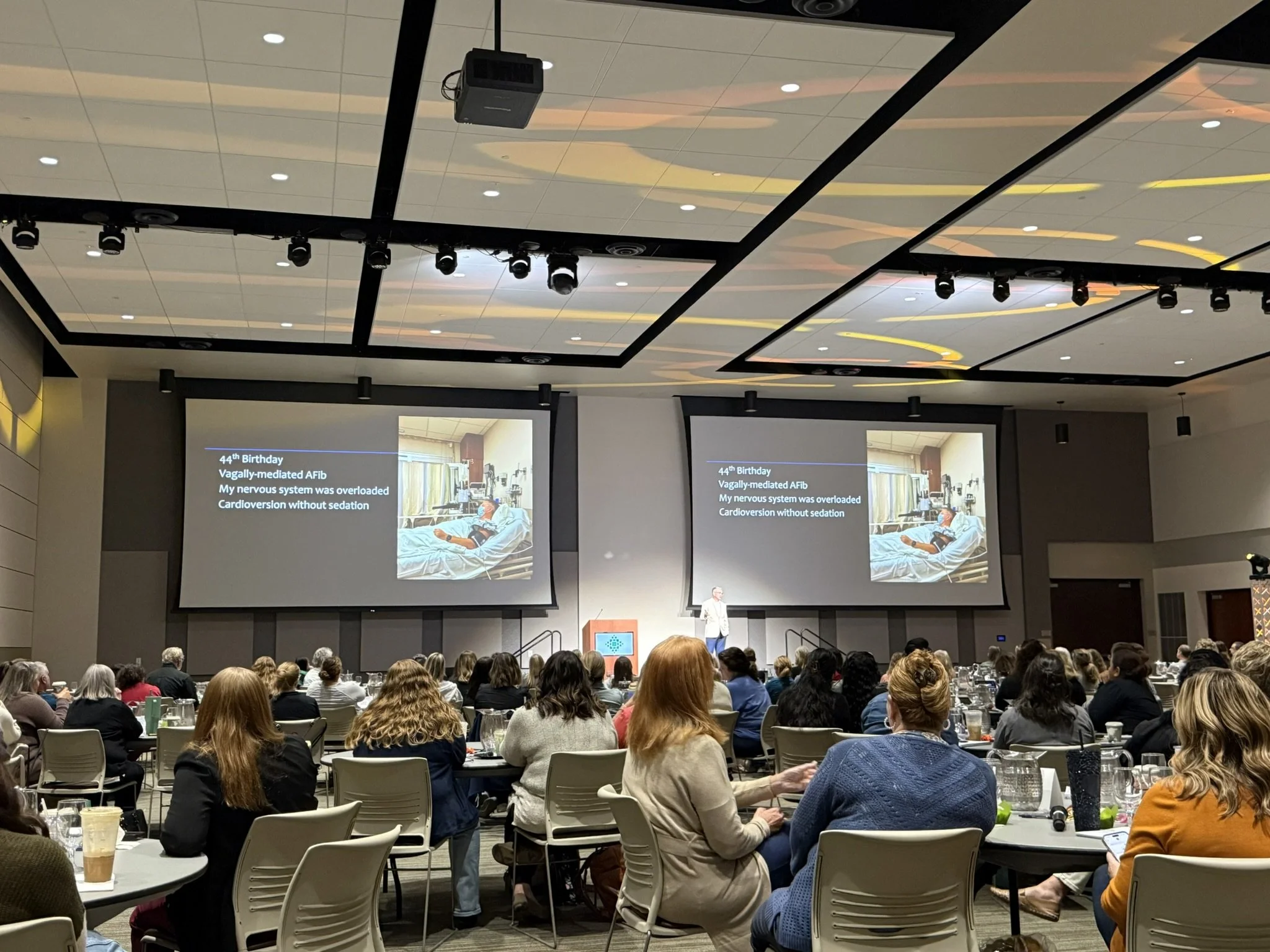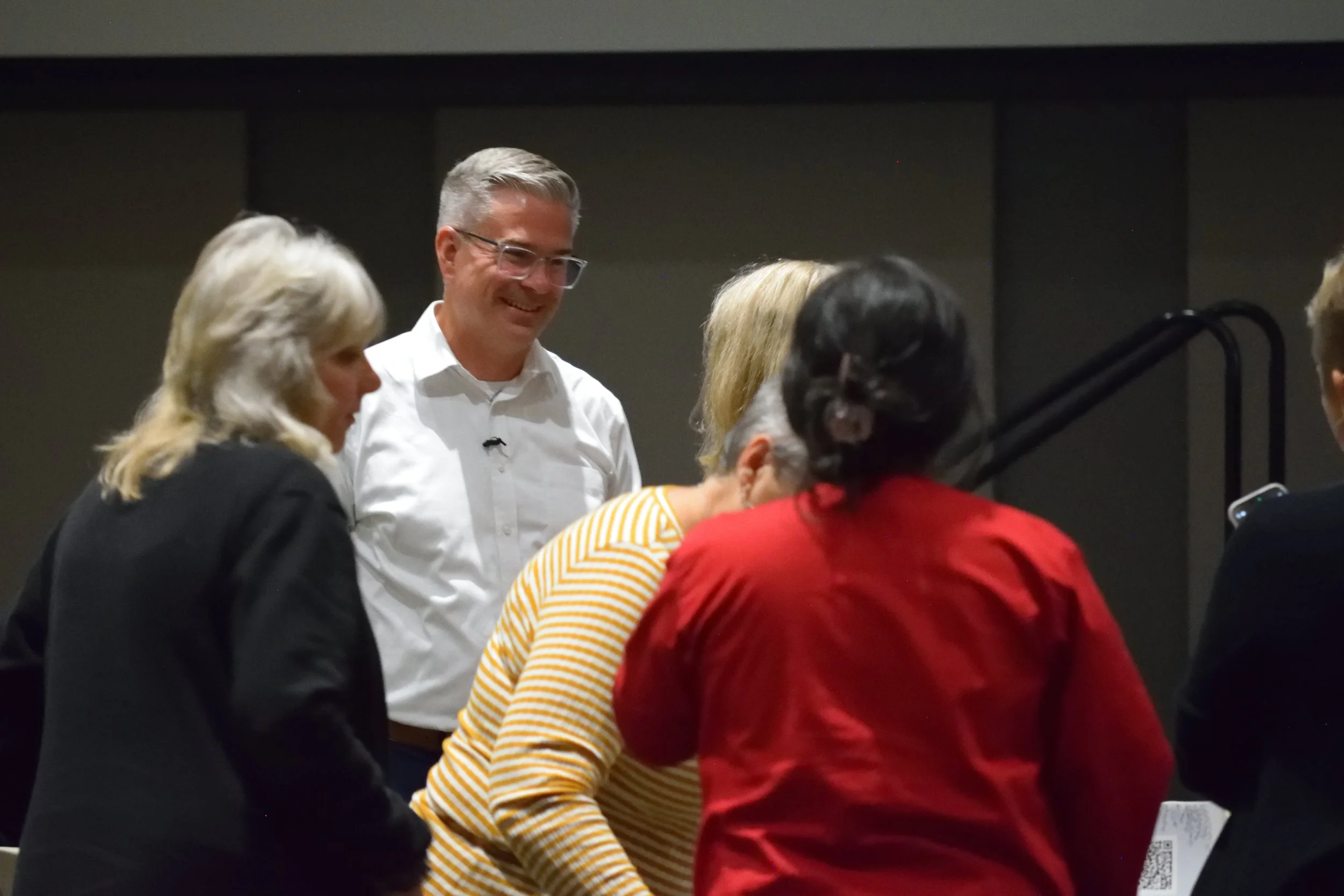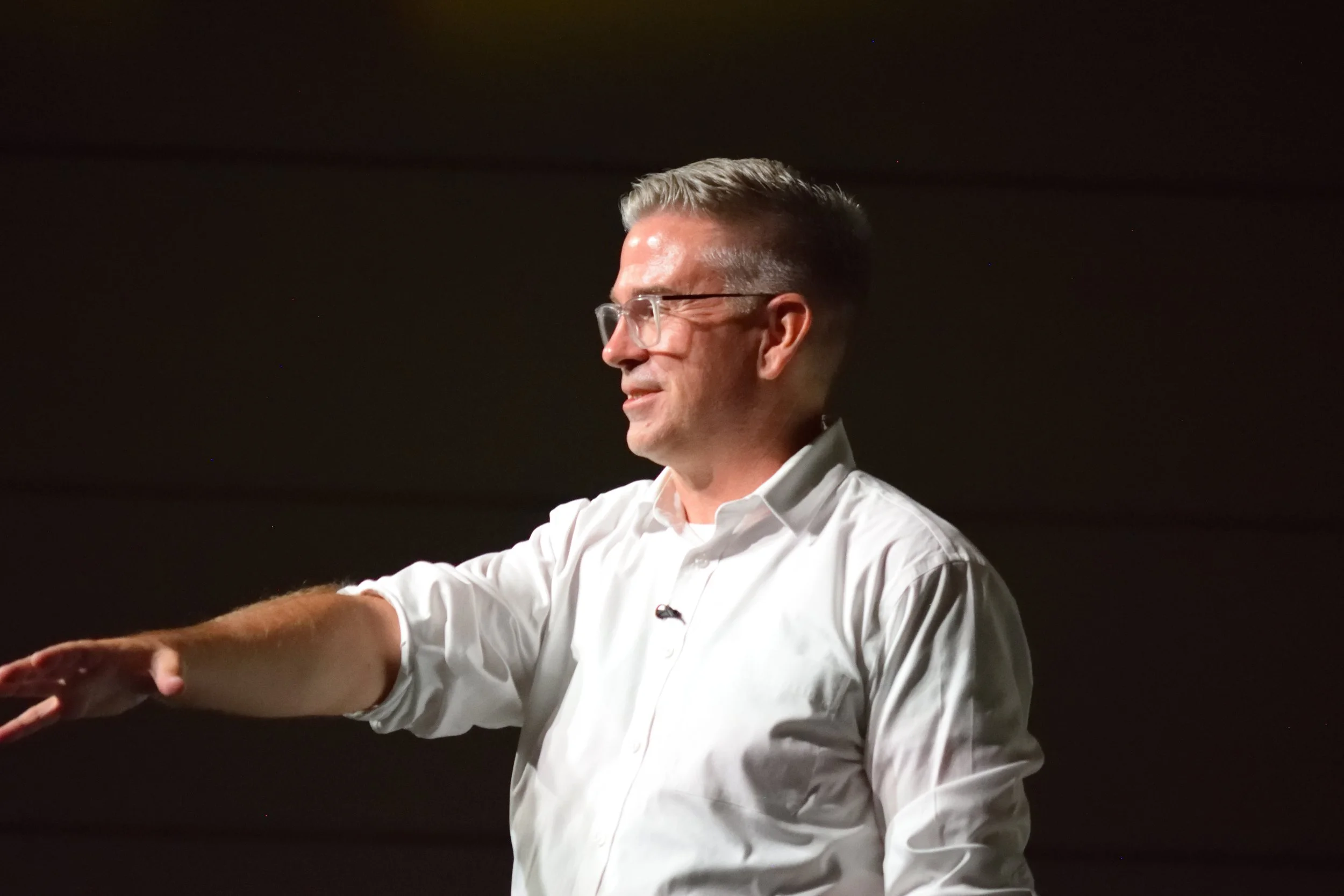Healthcare Burnout Blog and Resources
by Patrick Riecke
Healthcare workers and leaders are facing record levels of exhaustion, moral distress, and compassion fatigue.
This blog brings together practical tools, personal stories, and expert insights from burnout speaker and coach Patrick Riecke to help you prevent burnout, recover your sense of purpose, and restore wellbeing at work and beyond.
-
Let’s Talk About Healthcare Burnout: A Prevention and Recovery Guidebook by Rev. Patrick Riecke and Dr. Erin Alexander
This resource will guide your path to burnout prevention and recovery. This eBook provides actionable strategies, inspiring insights, and a clear path forward. Purchase your copy to begin transforming your experience.
-
Discover your level of burnout with our free online screening tool. This simple, science-backed assessment helps you understand emotional exhaustion, depersonalization, and personal accomplishment to identify your risk of burnout. Start your journey toward recovery today.
-
This affordable, life-changing mini-course helps you refocus your energy on what truly matters. Learn how to prioritize self-care and design a purpose-driven life while preventing burnout. Available exclusively for $24.99. Sign up here.
-
Whether you're an individual recovering from burnout or a leader looking to help your team, I offer tailored workshops, keynotes, and coaching. Let’s work together to create lasting change and improve wellbeing in your life or organization. Contact Patrick today.
-
Get personalized support through 1-on-1 executive coaching sessions designed to help you understand and combat burnout. Together, we’ll develop a plan to renew your energy, improve work-life balance, and thrive. Click here for coaching.
From Zero to Two: The Power of Small Growth
We all have areas of life where we feel completely incompetent. Not just “a little shaky,” but truly: “I-don’t-even-know-which-tools-to-use” incompetent.
For me, “craftsmanship” (working with my hands) has always been that category.
Back in college, I took a spiritual gifts assessment. My score for craftsmanship? A flat zero. 🤣
From Zero to… Maybe a Two
Fast forward 25 years. I’d love to say I’ve become a skilled mechanic or handyman. The truth? At best, I’ve crawled my way up to a solid two out of ten.
Case in point: my recent attempt to replace the car radio in my daughter’s 2006 Honda Accord.
It wasn’t pretty. It wasn’t smooth. At one point, wires were everywhere, and I found myself questioning my life choices.
But here’s the key: I got it installed.
Now she has Bluetooth, Apple CarPlay, and navigation in a car that’s older than she is. More importantly, she’s driving around smiling and singing, enjoying her upgraded ride.
Her joy made my frustration worth it.
Growth Isn’t About Mastery
That project reminded me of something important: growth doesn’t come from magically becoming good at something.
It comes from showing up, trying, failing, learning, and then moving one step forward.
That’s how it’s been with starting and growing our business, too. Kristen and I used to say:
“We don’t know anything about running a business.”
Now we say:
“We’re learning about running a business.”
The shift isn’t about reaching perfection. It’s about adopting a learning mindset.
Why This Matters for Work and Life
Whether you’re leading a team, building a business, or simply trying to grow personally, the principle is the same:
You don’t need to be a ten to make progress.
Even moving from zero to two is growth.
The goal isn’t mastery. It’s momentum.
A Question for You
Where in your work or life do you feel like a total zero?
And what’s one small step you could take this week to turn that zero into a two?
Because progress isn’t about perfection. It’s about courage, persistence, and the joy that comes when growth (however small) pays off.
Supporting a Grieving Coworker: Why Leadership Matters
When a coworker loses someone close, everything changes.
How leaders and workplaces respond in those moments doesn’t just affect the next few weeks. It can impact that coworker’s engagement, trust, and sense of belonging for years to come.
That’s why this month on The Burnout Hub, our Featured Resource is Week 48 of the Leadership Training Path:
“When a Coworker is Grieving the Death of a Loved One.”
Why Workplace Grief Response Matters
Grief doesn’t stay at home. When a coworker experiences the loss of a loved one, the ripple effects reach into the workplace. How leaders handle that moment can either build a culture of compassion or deepen disconnection and burnout.
Responding well matters because:
It communicates to employees that they are valued as people, not just workers.
It builds trust and loyalty during one of life’s hardest seasons.
It helps the grieving coworker return to work with a sense of safety and belonging.
Practical Ways Leaders Can Support a Grieving Coworker
In this short training, I share ways leaders can take meaningful action:
Show up with compassion without overstepping – presence matters more than perfect words.
Support both the grieving coworker and the rest of the team – loss impacts everyone differently.
Create space for healing while still navigating workplace realities – balancing compassion with organizational needs.
What’s Included in This Training
The resource doesn’t stop at ideas—it provides tools you can use right away:
📄 A downloadable reflection PDF to help leaders think intentionally about their response.
📖 A bonus download of my book on grief for deeper learning and personal growth.
Why This Training Is Part of The Burnout Hub
Supporting grieving coworkers is just one of the 100+ micro-trainings inside The Burnout Hub. Each week, leaders are given practical, real-world strategies to prevent burnout, foster resilience, and lead with compassion.
The 52-Week Leadership Training Path equips leaders to:
Build healthier workplace cultures.
Respond with confidence during times of stress and crisis.
Prevent burnout before it takes hold in their teams.
Organizations across the country are beginning to use The Burnout Hub to make sure their leaders have resources like this—when it matters most.
Start the Conversation
If your organization doesn’t yet have access to The Burnout Hub, this might be the right time to begin. Your team doesn’t just need policies or productivity goals. They need leaders who know how to respond when life happens.
👉 Explore this month’s featured content.
Because the way we respond to grief shapes not just the moment—but the entire future of our teams.
Burnout, Agoraphobia, and Healing: My Personal Journey
Burnout doesn’t just drain your energy at work—it can spill into every part of your life. For me, one of the hardest and least-shared parts of my burnout journey was agoraphobia.
Agoraphobia meant I felt anxious in groups, meetings, or even simple gatherings. While I’ve always leaned introverted, this was different. You’re not supposed to panic on your way to the grocery store or feel dread before a family function. But from about 2021 through 2023, that was my reality.
The Hidden Indicator of Burnout-Related Agoraphobia
The clearest signal that something was wrong? The overwhelming joy I felt whenever a meeting was cancelled.
Sure, a last-minute cancellation can feel like a blessing to anyone. But for me, the relief was out of proportion. I wasn’t just glad to have time back—I was escaping anxiety. Social obligations felt heavy, meetings felt suffocating, and even casual gatherings made me want to retreat.
This was burnout mixed with social anxiety, and it made daily life difficult.
Signs of Healing from Burnout
The turning point came recently when a colleague cancelled a meeting we had scheduled. Instead of relief, I felt… disappointed. I realized I had been looking forward to connecting with them.
That moment stopped me in my tracks. It was evidence that something had shifted inside me.
I’ve noticed other changes too:
I enjoy going out with my wife, Kristen, to places like Vinland Winery or a local high school football game.
I appreciate running into people at the coffee shop again.
And I don’t celebrate every cancelled meeting anymore. Sometimes, I even miss them.
These may seem like small things, but for me, they mark a huge step forward in burnout recovery.
Burnout and Social Anxiety: Not Always Connected, But Sometimes Linked
Not everyone who experiences burnout also develops agoraphobia or social anxiety. But for me, the two were intertwined. As the burnout lifted, so did the fear of social situations.
That’s why this milestone feels so important: my body and mind are both healing.
A Reminder for Anyone Facing Burnout
If you find yourself dreading connection, avoiding people, or feeling anxious about ordinary events, you’re not broken. Burnout and social anxiety can overlap and recovery takes time.
But healing is possible. One day you may notice, like I did, that you’re no longer celebrating every cancellation. Instead, you might be looking forward to the conversation, the connection, or even the crowd.
That shift is worth noticing, and worth celebrating.
The Burnout Hub: Real Solutions for Burnout Recovery and Prevention
Burnout is everywhere.
Leaders are exhausted.
Teams are overwhelmed.
And too many people are quietly wondering how long they can keep this up.
If that sounds familiar, you’re not alone. Burnout has become one of the biggest challenges facing today’s workforce. But there are real solutions—and that’s why we built The Burnout Hub (TBH).
What Is The Burnout Hub?
The Burnout Hub is an on-demand resource designed to help both individuals recover from burnout and equip leaders to create healthier workplaces. Instead of vague motivational slogans, TBH offers practical tools and step-by-step guidance that you can put into action immediately.
Inside The Burnout Hub
When you join TBH, you’ll find a comprehensive set of resources tailored to both personal recovery and leadership development:
Two Clear Paths
Personal Recovery Journey: A 5-Week Burnout Recovery Kickstart to help you rebuild energy, regain clarity, and rediscover balance.
Leadership Training Path: A 52-Week Leadership Development Program with weekly lessons that show leaders how to reduce burnout, foster psychological safety, and build resilient teams.
The Download Hub
Access 25+ printable PDFs, guides, and tools ready to use, share, and apply in real workplace situations.
Certificates of Completion
Earn recognition as you progress through the Leadership Training Path. These certificates can be added to professional development plans or employee growth initiatives.
Live Group Coaching Calls
Each month, you can join me and a community of leaders and coworkers for real conversations about burnout. These live sessions provide actionable strategies, encouragement, and connection.
Why The Burnout Hub Works
Most employees don’t need another motivational poster or a one-time seminar. They need ongoing tools, real conversations, and a clear path forward.
The Burnout Hub was designed to remove the guesswork. Whether you’re an individual searching for recovery, a leader trying to support your team, or an organization looking for scalable solutions, TBH meets you where you are—and helps you take the next step.
Start Your Burnout Recovery or Leadership Path Today
Burnout doesn’t have to define your career, your leadership, or your organization. With The Burnout Hub, you’ll gain access to proven frameworks, practical tools, and a supportive community—all designed to help you and your team thrive.
93% of Healthcare Workers Report Burnout: What We Learned in One Powerful Day
Last week, I had the privilege of leading my very first full-day conference on burnout. Walking into a room full of healthcare professionals, I could feel both the weight of their responsibilities and their hunger for real solutions. By the end of the morning, one thing was clear: nearly everyone in that room had felt the sting of burnout. In fact, 93% of participants said they had experienced at least one characteristic of burnout in the past year.
That statistic doesn’t surprise me anymore, but it still stops me in my tracks. Burnout isn’t just an occasional challenge—it’s the room we’re all sitting in. And yet, when we gather to talk openly about it, something powerful happens: relief, connection, and the beginning of recovery.
A Day of Conversations, Not Just Content
This wasn’t just another lecture. Throughout the day, we talked. I built time into each session for “Table Talk,” five-minute conversations at every table where coworkers could process what they were hearing and apply it to their own experience. The room came alive in those moments. Leaders, nurses, social workers, and other professionals leaned in, asked questions, and reflected honestly on their struggles.
We also experimented with live polls and Q&A. What stood out was how eager people were to engage. Anonymous questions poured in. Real, raw concerns about leadership, team support, and how to keep going when exhaustion sets in.
What Stood Out
For me, this day marked the first time I presented on some new topics like management tactics, difficult conversations like discipline and even firing, and how grief support intersects with burnout recovery . These aren’t easy subjects, but they are real, and people in the room knew it. Many of the attendees were leaders, and they weren’t shy about voicing their need for guidance.
The feedback confirmed that vulnerability matters. Over and over, participants wrote that hearing personal stories—my own experiences with burnout, as well as stories of others—was what made the day meaningful. It reminded me why I keep telling my own story: not because it’s comfortable, but because it opens the door for others to tell theirs.
How Attendees Responded
At the end of the day, we asked people to rate the presentation on a scale of 1 to 5. The average score came back at 4.94 out of 5. But more than the number, it was the comments that encouraged me most.
When asked which practices they planned to use for recovery, the most common responses were striking. Many people said they would start by making a bucket list; a reminder that burnout recovery isn’t only about reducing stress but also about rekindling joy. Others committed to adjusting expectations of themselves, paying attention to their nervous systems, and drawing boundaries. These are simple, human practices, but they create real change.
Why This Matters
If there’s one headline from the day, it’s this: burnout is common, but it’s not inevitable. When 93% of people in the room say they’re experiencing symptoms, we have to pay attention. And when leaders and coworkers have the courage to talk about it together, we can start to change the culture.
Burnout doesn’t go away because we hope it will. It requires awareness. It requires solutions. And most of all, it requires conversation. That’s what this day was about—opening the conversation and then moving toward practical steps for both personal recovery and organizational change.
Looking Ahead
As I reflect on this event, I’m grateful for the people who showed up with honesty, for the conversations that sparked courage, and for the hope that continues to rise when we take burnout seriously. This wasn’t just a one-day conference. It was a glimpse of what can happen when organizations choose to talk about the hard things and equip their people with tools to recover and thrive.
My hope is that this kind of conversation doesn’t stay contained to one room on one day. It’s needed everywhere because the people doing the hard work of caring for others can’t afford to burn out themselves.
Closing Thought
If your organization is ready to raise awareness about burnout and explore real solutions, I’d love to be part of that conversation.
Written by Patrick Riecke, Burnout Awareness Advocate





